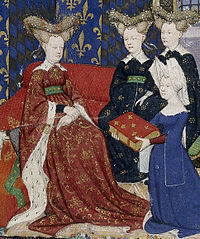
On International Women's Day, we're honoring our pioneers to whom we owe a great debt, and Christine de Pizan is one of our earliest and most eloquent pioneers.
She defended the moral character of women during the viciously sexist Romance of the Rose debates. She penned more than 20 volumes of work at a time when no lay woman wrote at all. She wrote the only poem championing Joan of Arc during her lifetime. Her writing is still taught in universities as one of the great voices of the Middle Ages.
Ambition as a Drug
Genuine people, however, are multi-dimensional and the faceted sides of the human psyche give us an opportunity to examine the truth behind each side of the story of Christine de Pizan, in this case the addictive and conflicted nature of ambition.
For example, all pioneers waffle between the inculcated lessons of the status quo (giving rise to self-loathing) and their determined, brilliant will to move forward. Pioneers know their position as an out-cast, as Christine does when she acknowledges that she is a raptor (ferocious and potentially deadly) amid a court of decorative and powerless blue-bird women. She sometimes feels reptilian in her alienation.
Read More








